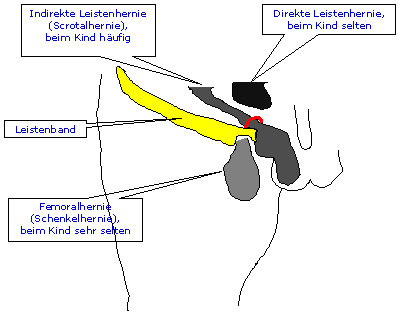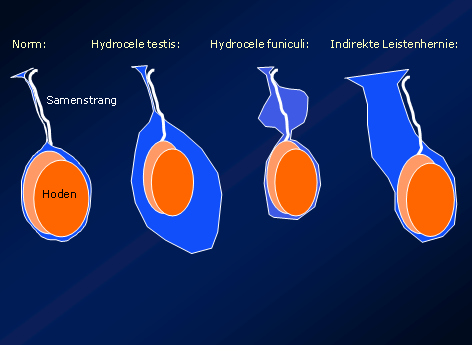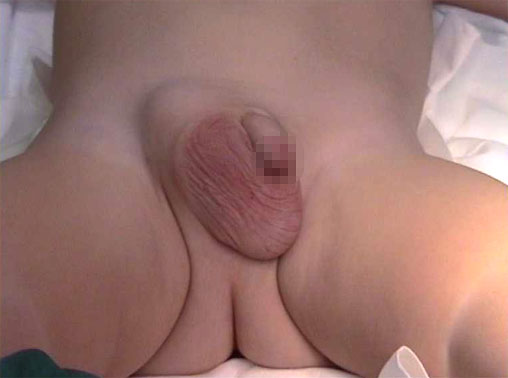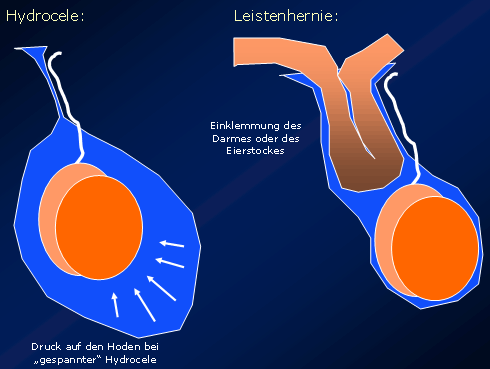Groin hernias (Inguinal hernias) and hydrocele in infancy and childhood:
Groin hernias, also known as inguinal hernias, are a very common in infancy and childhood. 0.8% to 5% of all children are affected. Hernias are usually caused by the failure of obliteration of the processus vaginalis, a sac like structure that derives from the peritoneum (inner lining of the abdominal cavity) and lies within the inguinal canal. In boys this canal contains the spermatic cord and in girls a band like structure that inserts at the uterus to stabilize it, called the rotundum ligament.

1. Indirect inguinal hernia (inguinoscrotal hernia), common in children
2. Direct inguinal hernia, rare in children
3. Inguinal ligament
4. Femoral hernia, very rare in children
Nearly all inguinal hernias in children are indirect. Here, the hernial sac has developed directly out of a patent processus vaginalis and lies oblique in the inguinal canal. The hernial sac contains organs that have tracked down from the peritoneal (abdominal) cavity through the internal inguinal ring, such as small bowel, omentum or even an ovary.
80% of infants in their very first year of life have an open inguinal canal to some degree, but only few will form a hernia. The prevalence of a patent inguinal canal throughout the entire lifetime may be as high as 20%, but again the majority will never form a hernia. The strength of the abdominal muscles and the quality of the connective tissue determine weather an inguinal hernia will develop out of a patent inguinal canal or not. Obliteration and closure of the processus vaginalis usually occurs within the first 6 month of life. Therefore the greatest incidence of inguinal hernias in children is in the very first year of life. 16 to 25% of all premature babies are affected. The incidence in boys is up to 10 times higher then in girls. 12% have a disposition within the family. 60% of these hernias are on the right side, 30% on the left and 10% bilateral. 5% of children, who initially have a unilateral hernia, go on to develop a hernia on the opposite side later on, most of them within one to five years after the operation. We don’t routinely explore the other side during surgery, especially in the male child. However, we will explore if suspicion arises from a thorough clinical examination.
Another condition may develop in a very similar way. When peritoneal fluid tracks down a narrow but patent processus vaginalis it forms a hydrocele in boys and a so called diverticulum Nucki in girls. In infants this condition tends to close and absorb spontaneously and often requires only surveillance and regular check ups. However, occasionally a “flap valve” mechanism leads to high pressures and this may impair the blood supply of the testicle. In this situation it may be necessary to operate more urgently to prevent testicular damage. For a hydrocele with low pressures an operation can often be postponed.
Direct inguinal hernias and femoral hernias are very rare in infancy and childhood.


A simple but thorough clinical examination is diagnostic. Occasionally an ultrasound is performed to confirm the clinical diagnosis.
Inguinal hernias don’t resolve spontaneously! Surgery is always necessary and should be performed within one month after the diagnosis has been made. Following our time guidelines we are able to prevent 90% of possible complications.
Incarceration or strangulation is the most significant complication of indirect inguinal hernias. A loop of bowel or in girls even an ovary (hernia ovarica) gets trapped in the hernial sac. In this situation the blood supply of the effected organs and in boys of the testis is at risk to become compromised. Without treatment the effected testis is likely to shrink and lose its function. Up to 70% of strangulated hernias are seen in infants less than 6 month of age. This is a very serious condition and it is very painful (crying, unable to be pacified, legs are thrown up and bent in the hips). Vomiting will occur sooner due to a vegetative reflex or later as a sign of bowel obstruction. The doctor will try to manually reduce the hernial sac. Sometimes while bathing the child in warm water. In most of the cases this will be successful. However, if several attempts have been unsuccessful an immediate operation will be necessary. When the hernia has been manually reduced, surgery should be performed a few hours later, to give time for the oedema to subside.

1. Hydrocele: possible high pressures
2. Inguinal hernia: bowel or an ovary gets trapped
Inguinal hernias don’t resolve spontaneously like umbilical hernias do. Surgery is always necessary. The surgical technique is entirely different to the one used in adults. The technique aims to avoid the occurrence of pressure on the spermatic cord during the growing process of the child. The surgeon should operate with visual magnification that will allow her/him to identify and secure all the fine structures of this region. (blood vessels and spermatic cord at this age are no thicker then 1 millimetre).
It is still an open question amongst the leading specialists weather it is necessary to routinely explore the opposite side during surgery. In boys we only explore the other side if suspicion arises from a thorough clinical examination. In girls we explore the opposite side more often. In girls there is no risk for damaging the spermatic cord during the operation (risk in boys less then 0.05%) but there is a risk later on of developing an inguinal hernia during pregnancy if the processus vaginalis remains patent. The risk of recurrence after eventless surgical repair is 0.8 to 1.2% and is generally higher in boys. If the inguinal canal, formed by muscles and connective tissue, is particularly wide, we use a special suturing technique, called “laterale Pfeilnaht” to reduce its width. This technique brings down the abnormally high edge of the inner oblique abdominal muscle by suturing it to the inner side of the inguinal ligament. Infections due to surgery are extremely rare. The side of the operation will be covered by a water repellent dressing, which should stay on until the sutures are to be removed.
During the operation of a hydrocele we need to identify the tiny canal through which peritoneal fluid is able to track down. This canal is no wider than a millimetre.
Premature babies are at particular risk of developing difficulties in breathing and apnoea after surgery. Therefore we do not recommend this operation as a day case in prematures. An over night stay after the operation should be considered even for older infants.
Direct inguinal hernias, as found in adults are very rare in infancy and childhood and account for only 1 – 4% of hernias in this age group. This condition develops in a different way then direct inguinal hernias do. Femoral hernias are another rare form. A hernial sac has tracked down, underneath the inguinal ligament into the subcutaneous fat tissue of the inner side of the thigh. Here in particular, the surgical technique needs to take into account the individual anatomy of the child. It might be necessary to implant an artificial mash to prevent a recurrence.
Laparoscopy, widely known as key-hole surgery, as used in adults, does not play a major role for the repair of hernias in children. Recurrence and complications, such as adhesions and bowel obstruction are by far more common if a laparoscopic technique has been used.



